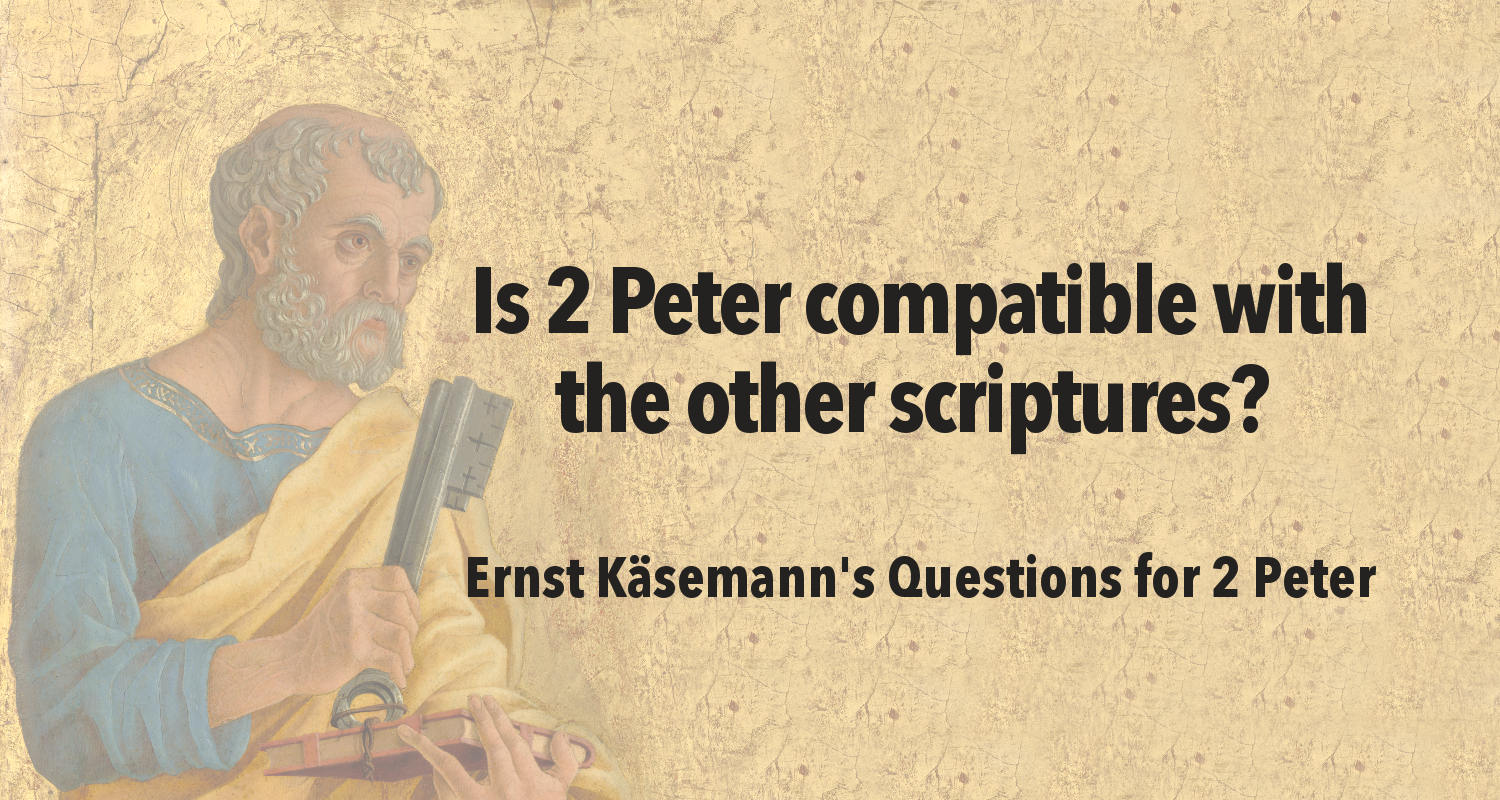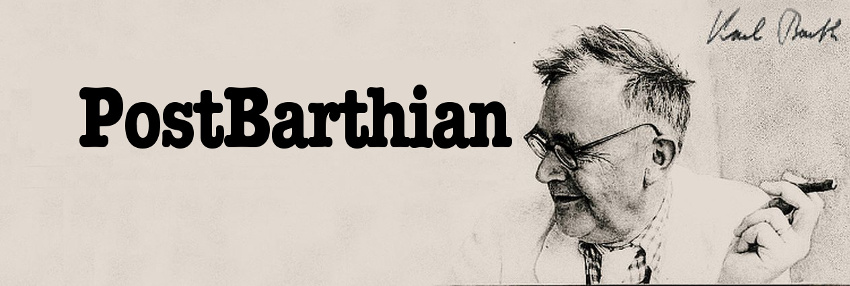 Why is 2 Peter included in the biblical canon? It's a question I ask myself often, as are all theologians who study it. Not only is the authorship dubious but it's theological content as well. Ernst Käsemann said that 2 Peter "is perhaps the most dubious writing in the canon" and his thorough criticism of 2 Peter in his essay "An Apologia for Primitive Christian Eschatology" raises grave questions, not only of its authorship, but whether 2 Peter is compatible with the Christian faith at all! In this post, I will summarize some of Käsemann's arguments against 2 Peter from this essay (available in Essays on New Testament Themes) and share his final questions about 2 Peter that must be answered in order to continue including it with "the other scriptures" (2 Peter 3:16).
Why is 2 Peter included in the biblical canon? It's a question I ask myself often, as are all theologians who study it. Not only is the authorship dubious but it's theological content as well. Ernst Käsemann said that 2 Peter "is perhaps the most dubious writing in the canon" and his thorough criticism of 2 Peter in his essay "An Apologia for Primitive Christian Eschatology" raises grave questions, not only of its authorship, but whether 2 Peter is compatible with the Christian faith at all! In this post, I will summarize some of Käsemann's arguments against 2 Peter from this essay (available in Essays on New Testament Themes) and share his final questions about 2 Peter that must be answered in order to continue including it with "the other scriptures" (2 Peter 3:16).
Käsemann says that the "Second Epistle of Peter was written as an apologia for primitive Christian eschatology" [2] because "to the anger of the writer . . . those fathers of the first Christian generation who still fervently expected the Parousia [the coming of Jesus] are dead, and the world goes on in the same way." [3] Käsemann argues that 2 Peter was written in "the middle of the second century" when unity of the early apostolic era had ended and various sects (especially gnosticism) had caused divisions in the church, and this epistle was written to address those present challenges to early Catholicism. Käsemann says that the "last days" mentioned in 2 Peter 3:3-4 actually describes the present challenges facing the church, not a future time of apostasy and that the "whole context [of 2 Peter 3:3-4] shows that this pronouncement has now come."
The author of 2 Peter claims to be "Simeon Peter, a servant and apostle of Jesus Christ" (2 Peter 1:1) but Kasemann says this is not true "according to the almost unanimous verdict of criticism, it [2 Peter] is the latest in date of all New Testament documents and in any event not written by the Apostle Peter." [4] Käsemann did not believe that the author was concerned about ethics of pseudonymity (like we are today) because the author believed its message was in continuity with the apostolic message, and that its message may attributed to Peter as basically a final testament of the chief apostle, and this claim is made in order to give authority to the author's message. "It is no accident that the pseudonymous writer shelters behind the authority of the Prince of the Apostles" [5] because apostolic authority was needed by the church during the rise of early Catholicism in order to give the church authority to suppress it's enemies.
Käsemann also demonstrates the late date for 2 Peter by showing that its content is consistent with the latest and most dubious writings in the New Testament, such as 2 Timothy and Jude, which describe a later time in church history after the first apostles had died and the delay of the parousia (i.e. return of Jesus) needed to be explained. "The error of false teachers in 2 Tim 2:18, who say that the resurrection has already happened, also springs from this conviction; and the modification of the view which we find in the Fourth Gospel, the deutero-Pauline epistles and the baptismal paraenesis of the New Testament." [6] Furthermore, 2 Peter exhibits direct dependence upon Jude and "Chapter 2 is, without any doubt, partly an extension and partly a revision of Jude" [7] and Käsemann proves this by saying that "the apocryphal literature of Jewish apocalyptic, which is freely quoted in Jude, is obviously and deliberately suppressed in ch. 2, this shows that, on the other hand, the canonical collection of Scriptures is already subject to critical sifting."
Kasemann believes the reference to the "other scriptures" (2 Peter 3:16) demonstrates not only that the biblical canon had already been collected (by this late time), that the canon had already been revised in a similar way that Jude was revised in 2 Peter 3. Additionally, the rejection of other interpretations in 2 Peter 1:20-21 demonstrates that the church was claiming hegemony on interpretation (similar to supporters of biblical inerrancy today) and rejecting anyone or anything that rivaled the church's authoritarian interpretation of the scriptures (as is it the same circumstance in 2 Timothy 3:16). (It is ironic that supporters of biblical inerrancy, who are likely the ones most likely to resist Kasemann's conclusions, use these two dubious verses 2 Peter 1:20-21 and 2 Timothy 3:16 as foundations for their theory of inspiration, in the same way.)
The challenge of 2 Peter is not its authorship or its late date, but the theological content it presents. Käsemann says that the angry author of 2 Peter prophesies a "universal holocaust" wherein "all the ungodly will be destroyed . . . in which only the righteous remain." [8] Käsemann's other criticisms of 2 Peter's theological content are revealed in his conclusion questions (which I have shared at the end of this post) and may be learned by reading the essay! So I will not summarize them all here.
In order to accept 2 Peter, Käsemann concludes his essay with a set of questions that must be answered beforehand, and so far none of the defenders of 2 Peter have provided satisfying answers to them:
What have we to say about an eschatology, which, like that of our epistle, is concerned only with the hope of the triumphal entry of believers into the eternal kingdom and with the destruction of the ungodly?
What have we to say about the canon, in which II Peter has a place as the clearest possible testimony to the onset of early Catholicism?
What have we to say about a Church, which is so concerned to defend herself against heretics, that she no longer distinguishes between Spirit and letter; that she identifies the Gospel with her own tradition and, further, with a particular religious world-view that she regulates exegesis according to her system of teaching authority and makes faith into a mere assent to the dogmas of orthodoxy? [9]
Sources:
1. Ernst Käsemann, Essays on New Testament Themes, "An Apologia for Primitive Christian Eschatology", trans. W. J. Montague, (SCM Press, 1968: Great Britain), p. 169-195.
2. Ibid. p. 169
3. Ibid. p. 170
4. Ibid. p. 172.
5. Ibid. p. 176.
6. Ibid. p. 171
7. Ibid. p. 172
8. Ibid. p. 193
9. Ibid. p. 195



September 11th, 2018 - 08:46
It’s interesting reading the last quote from Kasemann, since most evangelicals have reduced Christianity into assenting to a series of dogmas and gleefully anticipating the destruction of the ungodly as well as a gnostic otherworldly salvation devoid of raising the dead and the transformation of the cosmos itself. Would you agree that 2 Peter’s presence in the canon has helped reinforce these ideas?